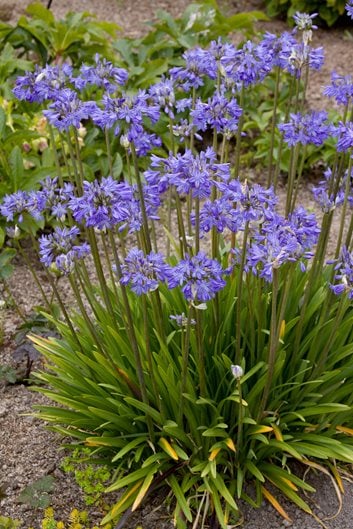Seasonal Agapanthus Care: Preparing for Winter Months and Summer season
Seasonal Agapanthus Care: Preparing for Winter Months and Summer season
Blog Article
Unleashing the Secret to Effective Agapanthus Cultivation: Advice for a Flourishing Garden
In the world of horticulture, cultivating agapanthus efficiently calls for a tactical technique that incorporates different elements of plant treatment. By understanding the nuances of agapanthus growing, one can develop a setting where these plants thrive and flower generously.
Growing Agapanthus: Ideal Practices
When planting Agapanthus, proper soil preparation is necessary for ensuring successful growth and advancement of these lovely blossoms. Agapanthus, generally known as Lily of the Nile or African lily, flourishes in well-draining soil with a slightly acidic to neutral pH level - Agapanthus. Before planting, it is vital to modify hefty clay dirts with natural issue such as garden compost or peat moss to boost drain and supply crucial nutrients for the plants
To plant Agapanthus, choose a location that receives full sunlight to partial color, as this will promote healthy growth and abundant blooming. Dig an opening two times the size of the plant's origin sphere and put the Agapanthus at the exact same depth it was previously growing. Gently backfill the opening with dirt, pushing down securely to eliminate any type of air pockets around the origins.
Water the freshly grown Agapanthus completely and remain to keep the soil evenly wet, specifically throughout the plant's active growing period. Agapanthus. Using a well balanced fertilizer once a month can even more support the plant's development and blooming. By complying with these best practices for growing Agapanthus, you can develop a sensational screen of these fascinating flowers in your yard
Suitable Soil Issues for Agapanthus
For optimal development and blooming success of Agapanthus plants, making sure the soil problems are perfect is crucial. Agapanthus likes soil that is rich in nutrients, so including a balanced plant food during the expanding season can promote healthy and balanced growth and vivid blooms.

Watering and Fertilizing Tips
To ensure healthy development and vivid blooms, proper watering and fertilizing techniques are essential for effective Agapanthus farming. Agapanthus plants profit from routine watering, especially throughout the expanding period.
When it concerns fertilizing Agapanthus, a well balanced go to my blog plant food with equal components nitrogen, phosphorus, and potassium can be applied in the springtime to advertise healthy development and blooming. Slow-release fertilizers are optimal for offering nutrients gradually over a prolonged period. Stay clear of over-fertilizing, as this can cause extreme foliage development at the cost of blooms.
In addition, integrating raw material like compost into the dirt can improve nutrient degrees and enhance soil framework, helping in the overall wellness of the Agapanthus plants. By complying with these watering and fertilizing ideas, gardeners can guarantee their Agapanthus plants prosper and produce magnificent screens of flowers.
Trimming and Deadheading Techniques
Correct pruning and deadheading strategies play an important role in keeping the health and appearances of Agapanthus plants, matching the essential techniques of watering and fertilizing for effective cultivation. Pruning Agapanthus entails eliminating invested flower heads, dead or yellowing leaves, and general shaping of the plant to advertise much better development. Deadheading, the process of eliminating discolored flowers, not just enhances the plant's look but likewise motivates additional flowering.
When deadheading Agapanthus, it is recommended to snip off the flower stem at the base utilizing sharp, tidy shears. This process reroutes the plant's power from seed production back right into origin and foliage growth, advertising a healthier and much more durable plant. Regular deadheading can prolong the growing duration of Agapanthus and avoid self-seeding, which can cause congestion.
In regards to trimming, Agapanthus typically gain from a light trim after blooming to clean up the plant and motivate fresh development. Cutting down the spent blossom stems and getting rid of any dead or damaged vegetation aids keep the plant's vigor and total look. However, it is vital to stay clear of reducing into the crown of the plant, as this can compromise its health and wellness.

Protecting Agapanthus From Vermins and Diseases
Implementing reliable pest and condition management techniques is crucial to guarding the wellness and vitality of Agapanthus plants in cultivation. One usual insect that affects Agapanthus is the Agapanthus borer, a caterpillar that passages into the plant, causing damages to the visit site flowers and leaves.
In addition to insects, Agapanthus are prone to diseases such as root rot and fungal fallen leave places. By staying alert and resolving pest and illness problems without delay, gardeners can assist their Agapanthus flourish and flourish.

Final Thought
To conclude, effective farming of agapanthus calls for correct growing strategies, ideal soil conditions, adequate watering and fertilizing, regular pruning and deadheading, and protection from insects and diseases. By following these tricks official source and tips, gardeners can ensure a flourishing yard loaded with attractive agapanthus blossoms. Agapanthus. Bear in mind to preserve constant care and attention to information to advertise the wellness and durability of these spectacular plants
When planting Agapanthus, proper dirt prep work is necessary for making sure successful growth and growth of these lovely blossoms.Water the newly grown Agapanthus thoroughly and continue to keep the soil equally damp, particularly during the plant's energetic growing period.For ideal growth and blooming success of Agapanthus plants, making certain the soil conditions are excellent is vital. When hair transplanting or planting Agapanthus, guarantee the soil is well-prepared to give the needed foundation for the plants to develop themselves efficiently. One usual pest that affects Agapanthus is the Agapanthus borer, a caterpillar that tunnels into the plant, triggering damage to the fallen leaves and blossoms.
Report this page